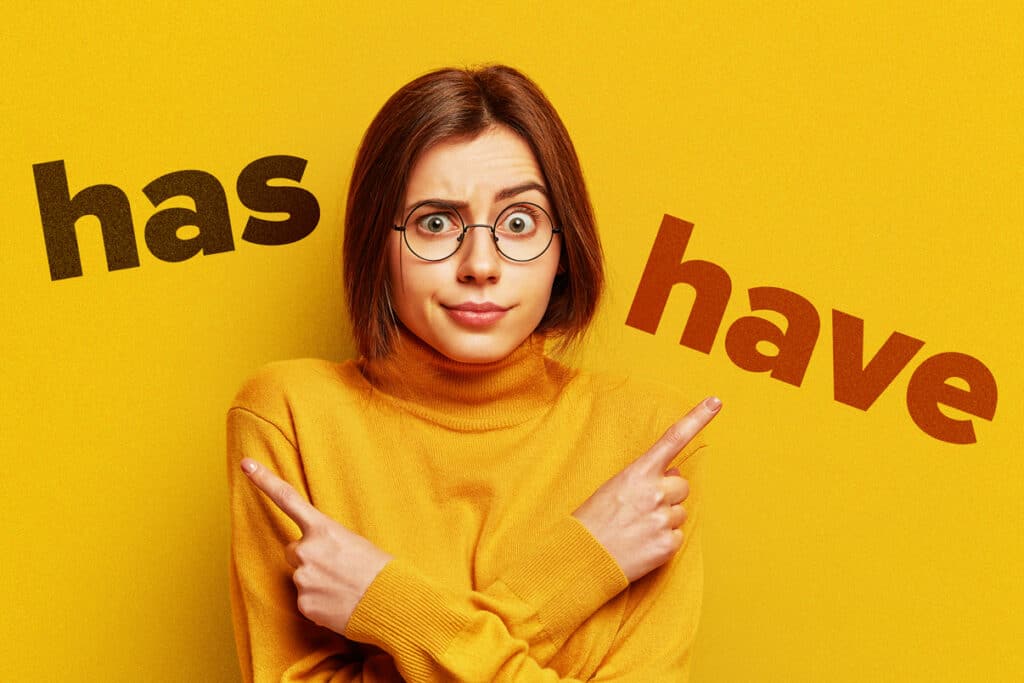
[ad_1]

As an English learner, you in all probability see the English phrases “has” and “have” incessantly.
In the event you’re a newbie English speaker, you may be confused about how you can use them. In that case, you’ve come to the best publish.
We’re going to crack the code and resolve the thriller of “has” vs. “have.”
Learn on to search out out about their fundamental variations and how you can use every correctly, plus useful observe assets!
Contents
Obtain:
This weblog publish is on the market as a handy and moveable PDF that you just
can take anyplace.
Click on right here to get a duplicate. (Obtain)
“Has” vs. “Have”: What’s the Distinction?
“Has” and “have” are each conjugations of the verb “to have.”
The principle distinction between them is that “has” is used with the third individual singular (he, she, it), whereas “have” is used for all different topics. The exception to that is with detrimental statements and questions, the place you all the time use “have.”
You possibly can consider the distinction as being all about factors of view.
In English, something we learn or communicate is coming from a specific standpoint. The standpoint tells you who’s talking, and who’s being spoken about.
You possibly can know the standpoint by which pronouns are used. Let’s rapidly evaluate:
| Level of View | That means | Singular | Plural |
|---|---|---|---|
| First Particular person | The speaker is speaking about himself or herself (with different folks included if plural). | I have | We have |
| Second Particular person | The speaker is speaking on to anyone else. | You have | You have |
| Third Particular person | The speaker is speaking about anyone or one thing else. | He has She has It has |
They have |
Received it? Nice! Now that you just perceive factors of view, utilizing “has” and “have” turns into very straightforward.
Within the Current Tense
“Have” and “has” can each be used within the current tense as a fundamental verb to imply possession.
Right here’s the distinction:
| Sort of Sentence | Has | Have |
|---|---|---|
| Affirmative Assertion | ✓ (he, she, it, singular nouns) | ✓ (I, we, you, plural nouns) |
| Adverse Assertion | 𐄂 | ✓ |
| Query | 𐄂 | ✓ |
Within the current tense, “has” is used with the third-person singular standpoint. Which means you’ll use it with “he,” “she,” “it,” a reputation or a singular noun.
It’s additionally used with singular pronouns like “all people,” “anyone,” or “no one”:
Everyone has a duplicate of the guide.
No person has the reply.
I don’t suppose anyone has espresso.
“Have” is used for the opposite factors of view–the first- and second-person factors of view, and the third-person plural standpoint.
In different phrases, use “have” with the themes “I,” “you,” “we” or “they”:
I have a headache.
You have a brand new laptop computer.
They have three cats.
We have an enormous home.
Additionally, use “have” with plural nouns or when speaking about a number of folks or issues on the similar time:
These clothes have stripes.
Roger and I have a pink automobile.
My canine and Patricia’s cat have brown fur.
Except for this, with detrimental statements or questions, you possibly can solely use “have” and never “has.” Even when the topic is “he,” “she,” “it,” a reputation or a singular noun, you’ll want to make use of “have.”
Listed here are some questions within the current tense, all utilizing “have”:
Does anyone have the reply to the query?
Do you have the guide?
Does she have a home?
The identical is true for detrimental statements within the current tense:
She doesn’t have a room.
I shouldn’t have a brother.
They shouldn’t have time to see you.
Within the Current Good Tense
“Has” and “have” will also be auxiliary verbs that assist create the current good tense, together with different verbs.
The foundations for utilizing them as auxiliary verbs are literally easier. It simply is dependent upon the topic.
If the topic is third-person singular: “he,” “she,” “it,” a reputation or a singular noun, you’ll all the time use “has”:
John has gone to California 4 instances.
The canine has not eaten right this moment.
Has she acquired the letter?
You’ll use “have” within the current good tense with topics “I,” “you,” “we” or “they,” in addition to plural nouns.
I have watched “Recreation of Thrones” 4 instances.
You have helped me lots.
They have requested many questions.
We have thought about this all day.
That is true for detrimental statements or questions too:
My associates haven’t watched “Recreation of Thrones.”
You haven’t helped me in any respect.
Have they requested too many questions?
The That means of “Has” and “Have”
Now that in regards to the variations between “has” and “have,” let’s evaluate the 2 fundamental makes use of of the verb “to have,” which is their infinitive, or authentic, type:
To Imply Possession
We use “to have” when we discuss possessing (proudly owning) one thing.
Listed here are some conjugations of the verb “to have”:
| Tense | Conjugation |
|---|---|
| Current | has, have |
| Current progressive | is / are having |
| Previous | had |
For instance, have a look at the next sentences:
She has the guide.
I have the guide.
In each sentences, the verb “to have” is conjugated within the current tense.
As Auxiliary Verbs
The verb “to have” has one other use. It’s additionally an auxiliary verb.
An auxiliary verb is mixed with one other verb to finish the that means of a sentence. Due to this, it’s additionally known as a “serving to verb.” For instance:
She has eaten dinner already.
I have seen that film.
These sentences each use the right tense. Right here, “has” and “have” don’t point out possession. As an alternative, including “has” or “have” to a different verb creates that verb’s good tense type.
Normally, the verb “to have” is essential as an auxiliary verb as a result of it creates the previous good and current good tenses for different verbs.
Contractions with “Has” and “Have”
In English, “has” and “have” are sometimes utilized in contractions—which is the place you mix two phrases with an apostrophe, and no less than one letter is eliminated.
Contractions are extremely frequent in casual English, whether or not in writing or talking. For extra formal varieties of writing, although, reminiscent of tutorial or enterprise writing, contractions are sometimes prevented, so that you spell the phrases out as an alternative.
Under are some examples of contractions combining “has” or “have” with private pronouns and different frequent phrases, and you may click on right here for our full publish on the subject.
| Authentic | Contraction |
|---|---|
| I’ve | I’ve |
| We have now | We have |
| You’ve | You have |
| He has | He is |
| She has | She’s |
| It has | It is |
| They’ve | They’ve |
| Ought to have | Hasn’t |
| Would have | Have not |
| The place has | The place’s |
| The place have | The place’ve |
“Has” or “have” will also be mixed with “not”:
| Authentic | Contraction |
|---|---|
| Has not | Hasn’t |
| Haven’t | Have not |
Learn how to Apply “Has” and “Have”
Working towards English grammar doesn’t have to be onerous or boring. There are numerous superb assets accessible on the web, plus different enjoyable methods to observe.
- Take on-line quizzes. Do this quiz on EnglishGrammar and this one on EnglishExercises. For on-the-go observe, try this worksheet from Research.com.
- Watch genuine English movies. Consider one thing you’re fascinated about, and discover English movies about it—you’ll hear “has” and “have” fairly incessantly! For instance, the language studying program FluentU has a big library of brief English movies for various learner ranges, with annotated subtitles. These make it simpler to note the context that “has” and “have” are utilized in.
- Attempt altering the pronouns on this article’s instance sentences. This is usually a good warm-up train. When you’ve modified the pronouns, change the verb to match.
- Write a paragraph from a number of factors of view. Attempt writing about your self, and use the verb “have” as many instances as you possibly can. Then, rewrite the paragraph as if it’s about anyone else. This may power you to observe the distinction between “has” and “have.”
Abstract: “Has” vs. “Have”
“Have” and “has” are each conjugations of the verb “to have” within the current tense. “To have” is usually related to possession or possession, but it surely will also be used as auxiliary (serving to) verbs within the current good tense.
Both means, whether or not within the current or good tense…
- Use “has” with the themes “he,” “she,” “it,” a identify or a singular noun.
- Use “have” with the themes “I,” “you,” “they,” “we,” a plural noun or a number of topics.
An exception to this is able to be should you’re making a query or detrimental assertion within the current tense. In that case, you’ll all the time use “have.”
Now, it’s time to make use of these essential phrases.
Research all of the examples intently. Use “has” and “have” in your every day conversations, and don’t be afraid of creating errors!
Obtain:
This weblog publish is on the market as a handy and moveable PDF that you just
can take anyplace.
Click on right here to get a duplicate. (Obtain)
[ad_2]